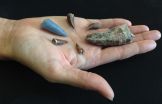(Press-News.org) Treating patients with high-dose radiotherapy after chemotherapy and surgery for malignant pleural mesothelioma does not achieve improvements in local relapse and overall survival, according to data from a prospective randomized phase II trial presented at ESMO 2014 Congress in Madrid.
"Mesothelioma remains a difficult disease to find better treatment options for, so we asked whether high-dose hemithoracic radiotherapy would decrease the rate or delay the time of local recurrence after chemotherapy and radical surgery," says lead author Prof Rolf A. Stahel, from the Clinic and Policlinic for Oncology, at the University Hospital Zurich, Switzerland, and current President of the European Society for Medical Oncology.
The multicentre trial included 153 patients with surgically-treatable malignant pleural mesothelioma, who were first treated with three chemotherapy cycles of cisplatin and pemetrexed, followed by surgical removal of affected lung tissue, with the goal of complete removal of the cancerous areas of lung.
In a second part of the study, researchers randomly assigned 54 patients to receive either radiotherapy or no further treatment, with the primary endpoint being the duration of relapse-free survival.
While there had been preliminary evidence suggesting that the addition of radiotherapy might improve outcomes, the study failed to find any differences in relapse-free survival between patients treated with the additional radiotherapy, and those who were not.
Stahel says researchers were hoping for a more positive signal from the study. "We aimed for a six month delay in local recurrence, which would be meaningful because it's an aggressive treatment for patients."
In summary, Stahel says, "It demonstrates that, like in other solid tumours, when two modalities are not sufficient it's very rare that the third modality added would make a benefit."
Commenting on the results, Dr Paul Baas, from the Department of Thoracic Oncology, The Netherlands Cancer Institute, Amsterdam, says the combined modality of chemotherapy followed by major surgery and irradiation of high volumes of the chest is one of the accepted treatments in very fit patients, however it is a combination associated with high morbidity.
"The study by Stahel et al. indicates that the contribution of radiation does not improve time to recurrence of the disease," says Baas.
However he also stressed that the results did not lead him to conclude that there was no role for adjuvant radiation in this setting, pointing out that this was a phase II trial, and therefore not necessarily the final conclusion, and that selection of patients with differing pathology, stage and performance could influence outcome.
"Times are changing and this is also true for the way that radiation therapy can be administered to the patient, so new approaches (intensity modulated radiation) can improve the local control and reduce toxicity."
Is PD-L1 a possible immunotherapy target in mesothelioma?
In a second study presented at the ESMO 2014 Congress, researchers report that about 20% of patients with malignant pleural mesothelioma have cancer cells that express a protein called programmed cell-death ligand 1 (PD-L1) that is associated with poorer outcomes.
The results suggest this population of patients could be treated with targeted therapies to PD-L1, researchers say.
The PD-L1 protein—which is part of the PD-1/PD-L1 immune pathway—is active in many different human cancers, where it is involved in suppressing the anti-tumor immune response and therefore hampering the immune system's ability to attack the cancer.
Treatments that block this pathway are already showing considerable promise in other malignancies, such as melanoma and lung cancer, leading researchers to question whether this same pathway could be active in malignant pleural mesothelioma.
"We report that PD-L1 is expressed in 20% of malignant pleural mesothelioma patients and is associated with poor outcome, which suggests that this pathway could be targeted with PD-1/PD-L1 inhibitors," says study author Dr Susana Cedres, from Vall d'Hebron Institute Oncology, Barcelona, Spain.
Researchers analysed tissue samples from 119 patients with malignant pleural mesothelioma using an anti-PD-L1 stain. PD-L1 expression intensity was scored on a scale of 0 to 3—with '0' signifying no expression, '1' signifying weak expression, '2' moderate, and '3' strong—and then compared the score with survival data and outcomes from those patients.
They found that overall, 20.7% of patients were positive for PD-L1 expression: 18.7% of these showed strong expression of PD-L1, 25% showed moderate expression, while 56.2% showed only weak expression of PD-L1.
Most importantly, patients who were negative for PD-L1 expression survived around 11 months longer than patients who were positive for PD-L1 expression (median survival 4.79 vs 16.3 months).
Factors such as gender, smoking, asbestos exposure and disease stage did not have an effect on whether patient's disease was positive for PD-L1 expression, but researchers did find that expression of the protein was more common in non-epithelial tumours compared to epithelial tumours.
"The results of our study could offer new treatment to this population of patients, identifying a subset of malignant pleural mesothelioma who expressed PD-L1 and could be treated with targeted therapies to PD-L1," Cedres says.
Commenting on the two studies, Baas says that finding a good treatment for mesothelioma has been a challenge for many years and has so far led to many disappointments, so there is a need for investigation into new pathways such as the use of immune checkpoint inhibitors that target the PD-1/PD-L1 pathway.
"Cedres and colleagues' data are important because they might help in selecting the best patients for these kinds of (expensive) therapies," Baas says.
Some key issues need to be addressed, such as identifying the best antibody and platform to find tumours with increased expression of PD-L1, and deciding which treatment approach to take.
"It is clear from these two studies that we still have a long way to go, but proper selection of patients, improved techniques in radiotherapy and new immunotherapy treatments will help us to fight this terrible disease."
INFORMATION:
Studies report new findings on treatment options for mesothelioma
High-dose radiotherapy adds no survival benefit after chemotherapy and radical surgery; PD-L1 protein a possible immunotherapy target
2014-09-29
ELSE PRESS RELEASES FROM THIS DATE:
Promising results shown with targeted approaches in subsets of non-small cell lung cancer
2014-09-29
The BRAF inhibitor dabrafenib has significant anti-tumour activity in patients with advanced BRAF V600E mutant non-small cell lung cancer whose disease has progressed after chemotherapy, according to phase II data presented at the ESMO 2014 Congress in Madrid, Spain.
"Reports of lung cancers bearing mutations in BRAF have generated considerable interest because these mutations may be associated with increased sensitivity to BRAF tyrosine-kinase inhibiting agents," says lead author Dr David Planchard, pulmonary oncologist at the Gustav-Roussy Cancer Campus, Paris, France. ...
Scientists make droplets move on their own
2014-09-29
Droplets are simple spheres of fluid, not normally considered capable of doing anything on their own. But now researchers have made droplets of alcohol move through water. In the future, such moving droplets may deliver medicines, etc.
To be able to move on your own – to be self-moving – is a feature normally seen in living organisms. But also non-living entities can be self-moving, report researchers from University of Southern Denmark and Institute of Chemical Technology in Prague, Czech Republic.
The researchers have made alcohol droplets move in a life-like way, ...
Avoid skunky beer this Oktoberfest with the help of chemistry
2014-09-29
WASHINGTON, Sept. 29, 2014 — Oktoberfest is here, and that means beer. And there's nothing worse than reaching for a cold one, taking that first sip and realizing your beer's been skunked: chemicals have reacted to form compounds that cause an awful, bitter taste. This week, Reactions explains why beers get skunky, and what you can do to keep your brews from going bad. Learn all about it at http://youtu.be/9i4dHdQzTFg.
INFORMATION:
Subscribe to the series at Reactions YouTube, and follow us on Twitter @ACSreactions to be the first to see our latest videos.
The American ...
Ancient human genome from southern Africa throws light on our origins
2014-09-29
What can DNA from the skeleton of a man who lived 2,330 years ago in the southernmost tip of Africa tell us about ourselves as humans? A great deal when his DNA profile is one of the 'earliest diverged' – oldest in genetic terms – found to-date in a region where modern humans are believed to have originated roughly 200,000 years ago.
The man's maternal DNA, or 'mitochondrial DNA', was sequenced to provide clues to early modern human prehistory and evolution. Mitochondrial DNA provided the first evidence that we all come from Africa, and helps us map a figurative genetic ...
DNA signature found in ice storm babies
2014-09-29
This news release is available in French. Montreal, September 29th, 2014 - The number of days an expectant mother was deprived of electricity during Quebec's Ice Storm (1998) predicts the epigenetic profile of her child, a new study finds.
Scientists from the Douglas Mental Health University Institute and McGill University have detected a distinctive 'signature' in the DNA of children born in the aftermath of the massive Quebec ice storm. Five months after the event, researchers recruited women who had been pregnant during the disaster and assessed their degrees of ...
Who are the men and boys suffering from anorexia?
2014-09-29
A new study by researchers from the University of Montreal reveals the current state of knowledge about anorexia in men and boys. "Most of the knowledge about anorexia pertains to females. However, about 10% of persons affected are males, and we believe this figure is underestimated," says Laurence Corbeil-Serre, lead author of the study. "Our results show that there appear to be similarities between the behavioural symptoms of males and females, but certain particularities can be identified in males, especially related to personality, gender identity, and sexual orientation."
The ...
Researchers show irradiation plus transplantation effective for treating HIV/AIDS
2014-09-29
Yerkes National Primate Research Center researchers are the first to show that an irradiation plus transplantation combination approach in nonhuman primates can be used to treat or even possibly cure HIV/AIDS, and this new model is providing some answers about the "Berlin patient," the only human thought cured of AIDS. The study is published in the September 25 issue of PLOS Pathogens.
Guido Silvestri, MD, division chief of Microbiology and Immunology at the Yerkes Research Center at Emory, and several of his research colleagues performed the first hematopoietic stem ...
Tooth buried in bone shows prehistoric predators tangled across land, sea
2014-09-29
About 210 million years ago when the supercontinent of Pangea was starting to break up and dog-sized dinosaurs were hiding from nearly everything, entirely different kinds of reptiles called phytosaurs and rauisuchids were at the top of the food chain.
It was widely believed the two top predators didn't interact much as the former was king of the water, and the latter ruled the land. But those ideas are changing, thanks largely to the contents of a single bone.
In a paper published online in September in the German journal Naturwissenschaften, Stephanie Drumheller of ...
Simulations reveal an unusual death for ancient stars
2014-09-29
Certain primordial stars—those 55,000 and 56,000 times the mass of our Sun, or solar masses—may have died unusually. In death, these objects—among the Universe's first-generation of stars—would have exploded as supernovae and burned completely, leaving no remnant black hole behind.
Astrophysicists at the University of California, Santa Cruz (UCSC) and the University of Minnesota came to this conclusion after running a number of supercomputer simulations at the Department of Energy's (DOE's) National Energy Research Scientific Computing Center (NERSC) and Minnesota Supercomputing ...
Myriad presents tumor BRACAnalysis CDx study at ESMO
2014-09-29
SALT LAKE CITY, Utah, Sept. 29, 2014 – Myriad Genetics, Inc. (Nasdaq: MYGN) today announced that its Tumor BRACAnalysis CDx™ companion diagnostic test significantly improved the detection of cancer-causing BRCA1/2 mutations by 44 percent in women with ovarian cancer. Data from this new study were presented at the 2014 European Society for Medical Oncology (ESMO) annual meeting in Madrid, Spain.
"Several previous clinical studies have demonstrated that patients with germline or somatic BRCA1/2 mutations respond to certain DNA-damaging medicines such as the platinum ...
LAST 30 PRESS RELEASES:
The vast majority of US rivers lack any protections from human activities, new research finds
Ultrasound-responsive in situ antigen "nanocatchers" open a new paradigm for personalized tumor immunotherapy
Environmental “superbugs” in our rivers and soils: new one health review warns of growing antimicrobial resistance crisis
Triple threat in greenhouse farming: how heavy metals, microplastics, and antibiotic resistance genes unite to challenge sustainable food production
Earthworms turn manure into a powerful tool against antibiotic resistance
AI turns water into an early warning network for hidden biological pollutants
Hidden hotspots on “green” plastics: biodegradable and conventional plastics shape very different antibiotic resistance risks in river microbiomes
Engineered biochar enzyme system clears toxic phenolic acids and restores pepper seed germination in continuous cropping soils
Retail therapy fail? Online shopping linked to stress, says study
How well-meaning allies can increase stress for marginalized people
Commercially viable biomanufacturing: designer yeast turns sugar into lucrative chemical 3-HP
Control valve discovered in gut’s plumbing system
George Mason University leads phase 2 clinical trial for pill to help maintain weight loss after GLP-1s
Hop to it: research from Shedd Aquarium tracks conch movement to set new conservation guidance
Weight loss drugs and bariatric surgery improve the body’s fat ‘balance:’ study
The Age of Fishes began with mass death
TB harnesses part of immune defense system to cause infection
Important new source of oxidation in the atmosphere found
A tug-of-war explains a decades-old question about how bacteria swim
Strengthened immune defense against cancer
Engineering the development of the pancreas
The Journal of Nuclear Medicine ahead-of-print tip sheet: Jan. 9, 2026
Mount Sinai researchers help create largest immune cell atlas of bone marrow in multiple myeloma patients
Why it is so hard to get started on an unpleasant task: Scientists identify a “motivation brake”
Body composition changes after bariatric surgery or treatment with GLP-1 receptor agonists
Targeted regulation of abortion providers laws and pregnancies conceived through fertility treatment
Press registration is now open for the 2026 ACMG Annual Clinical Genetics Meeting
Understanding sex-based differences and the role of bone morphogenetic protein signaling in Alzheimer’s disease
Breakthrough in thin-film electrolytes pushes solid oxide fuel cells forward
Clues from the past reveal the West Antarctic Ice Sheet’s vulnerability to warming
[Press-News.org] Studies report new findings on treatment options for mesotheliomaHigh-dose radiotherapy adds no survival benefit after chemotherapy and radical surgery; PD-L1 protein a possible immunotherapy target



